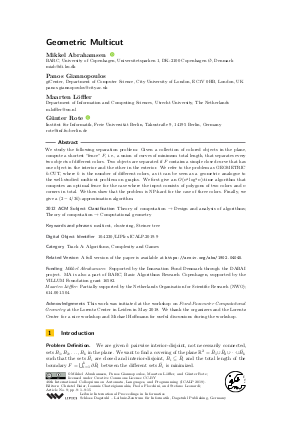@InProceedings{abrahamsen_et_al:LIPIcs.ICALP.2019.9,
author = {Abrahamsen, Mikkel and Giannopoulos, Panos and L\"{o}ffler, Maarten and Rote, G\"{u}nter},
title = {{Geometric Multicut}},
booktitle = {46th International Colloquium on Automata, Languages, and Programming (ICALP 2019)},
pages = {9:1--9:15},
series = {Leibniz International Proceedings in Informatics (LIPIcs)},
ISBN = {978-3-95977-109-2},
ISSN = {1868-8969},
year = {2019},
volume = {132},
editor = {Baier, Christel and Chatzigiannakis, Ioannis and Flocchini, Paola and Leonardi, Stefano},
publisher = {Schloss Dagstuhl -- Leibniz-Zentrum f{\"u}r Informatik},
address = {Dagstuhl, Germany},
URL = {https://drops.dagstuhl.de/entities/document/10.4230/LIPIcs.ICALP.2019.9},
URN = {urn:nbn:de:0030-drops-105850},
doi = {10.4230/LIPIcs.ICALP.2019.9},
annote = {Keywords: multicut, clustering, Steiner tree}
}

 Creative Commons Attribution 3.0 Unported license
Creative Commons Attribution 3.0 Unported license

